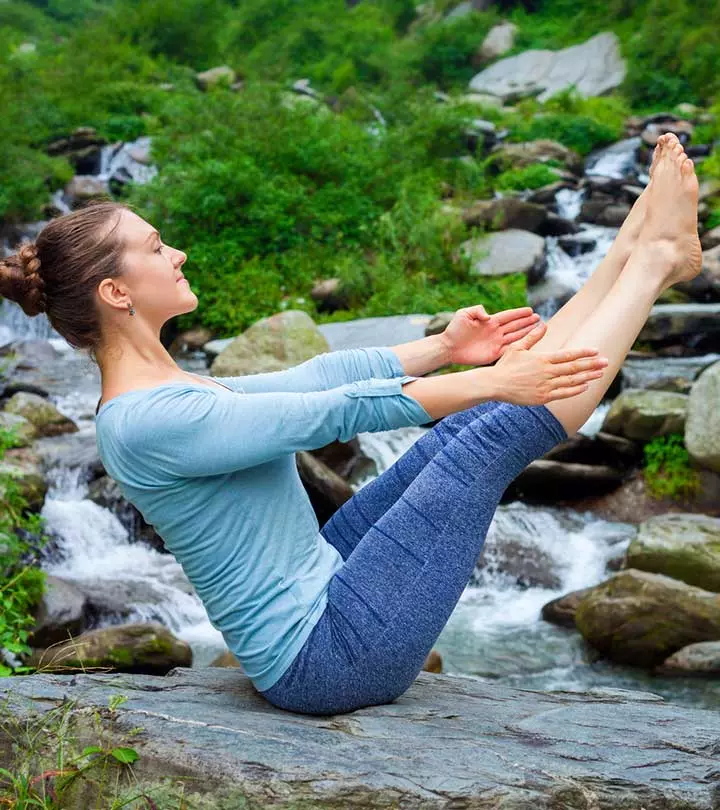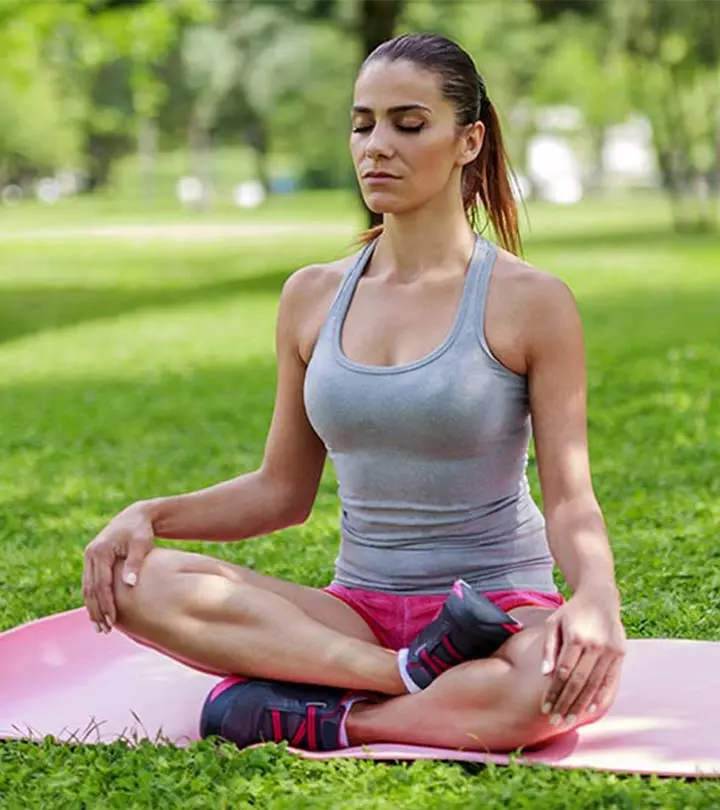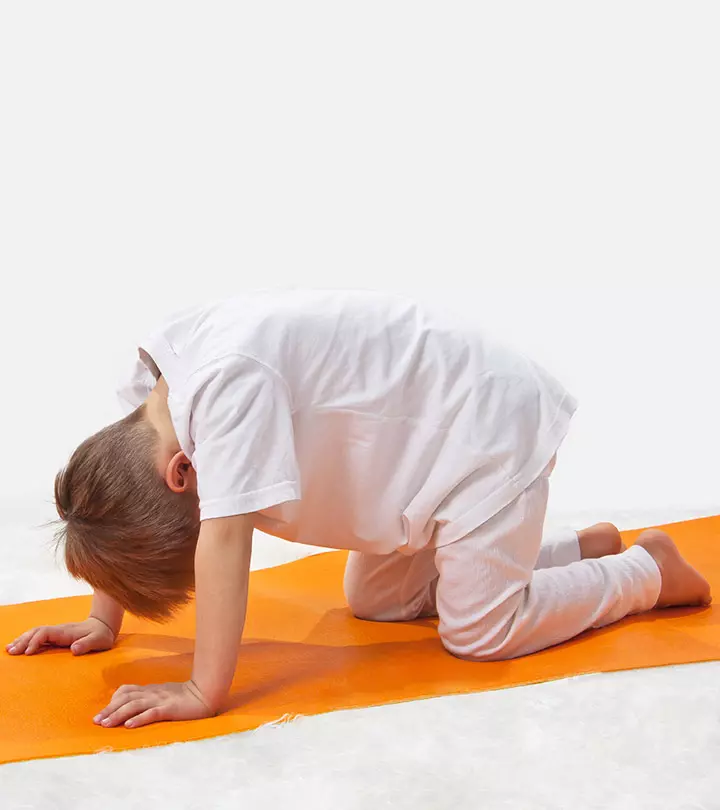How To Do The Padmasana And What Are Its Benefits
Master ancient sitting techniques to boost mindfulness, flexibility, and inner peace daily.

Image: shutterstock
Sanskrit: पद्मासन; Padma – Lotus, Asana – Pose; Pronounced As – pad-MAHS-anna
The lotus, or the Padma, is one of the most powerful symbols that is known to have transcended both religion and time. Over centuries, the lotus has been synonymous with detachment, rebirth, beauty, purity, spirituality, enlightenment, material wealth, and cosmic renewal. Right from Egypt to India, the lotus has been a part of many sagas. In the Hindu iconography, Goddess Lakshmi divinely seats herself on an open lotus. Even Lord Ganesha and Lord Vishnu are occasionally shown seated on the lotus. When we speak of Buddhism, it is said that wherever Buddha set foot, a lotus bloomed.
This asana emerges from such powerful fables from the past.
Everything You Need To Know About The Padmasana
- What You Should Know Before You Do The Asana
- How To Do The Padmasana
- Precautions And Contraindications
- Beginner’s Tip
- Advanced Pose Variation
- The Benefits Of The Lotus Pose
- The Science Behind The Padmasana
- Preparatory Poses
- Follow-Up Poses
What You Should Know Before You Do The Asana
This asana is a meditative pose, so it is best if you practice this pose in the morning. But having said that, there is no rule that you cannot meditate in the evening.
It is not mandatory that this asana must be done on an empty stomach. But if you are preceding or following it up with yoga asanas, it is best you have your meals at least four to six hours before you do this asana. Also, make sure that your bowels are clean.
Level: Intermediate/ Advanced
Style: Hatha Yoga
Duration: 1 to 5 minutes (Longer if meditating)
Repetition: Once with each leg on top
Stretches: Knees, Ankles
Strengthens: Spine, Abdomen, Pelvis, Bladder
How To Do Padmasana
- Sit on a flat surface on the ground with your spine erect and your legs stretched out.
- Gently bend the right knee, and use your hands to place it on your left thigh. Your soles must point upward, and the heels must be close to your abdomen.
- Do the same with the other leg.
- Now that both your legs are crossed, and your feet are comfortably placed on the opposite thighs, model your hands into a mudra of your choice and place it in position. Typically, the hands are placed on the knees.
- Remember that your head must be straight and the spine erect at all times.
- Breathe long and deep. Hold the position for a few minutes. Release.
- Repeat the pose with the other leg on top.
Note:
Mudras are known to activate the energy flow, and their effects are multiplied when practiced in combination with the Padmasana. Every Mudra is different, and so are their benefits. These are some Mudras that work wonders with the Padmasana – Chinmaya Mudra, Chin Mudra, Brahma Mudra, and Adi Mudra. Feel the energy flow as you practice this asana with the Mudra.
Precautions And Contraindications
These are some points of caution that you must keep in mind when you practice this asana.
- Avoid doing this asana if you have a knee or ankle injury.
- This asana must be practiced under the guidance of an experienced teacher, especially if you are a novice to this pose. It might look simple, but it is not.
Beginner’s Tip
As a beginner, you could overstretch your ankle as you get into the pose. To avoid this, you must push the inner side of the foot against the upper part of your arm so that your ankle’s stretch is balanced. Also, when you bring your foot near the opposite groin, make sure the stretch in the inner and outer ankle remains the same.
Advanced Pose Variation
Matsyasana will give you a deeper stretch if you want to intensify the Padmasana. Once you get into Padmasana, hold your feet, lift your chest, and lean backward, such that the crown of your head touches the floor. Here is the step by step account of how you can do this asana.
- Lie flat on your back, making sure your legs are together, and your hands are placed comfortably beside your body.
- Place your palms under your hips such that they are facing the ground. Now, bring the elbows closer to each other, placing them close to your waist.
- Cross your legs such that your feet cross each other at your middle, and your thighs and knees are placed flat on the floor.
- Breathe in. Lift your chest up such that your head is also lifted, and your crown touches the floor.
- Make sure the weight of your body is on your elbows and not on your head. As your chest is lifted, lightly pressurize your shoulder blades.
- Hold the position only until you are comfortable. Breathe normally.
- Exhale and release the position, lifting your head first, and then dropping your chest to the ground. Untangle your legs and relax. Repeat with the other leg on top.
The Benefits Of The Lotus Pose
These are some amazing benefits of Padmasana.
- This asana relaxes the mind and calms the brain.
- It activates the spine, the pelvis, the abdomen, and the bladder.
- The knees and ankles get a good stretch.
- Menstrual issues and sciatica are dealt with if this asana is practiced regularly.
- If this asana is practiced through pregnancy, it makes birthing easier.
- This asana opens up the hips, making them more flexible.
- This asana helps awaken the Chakras and also makes you more aware of things.
- Your posture is sure to improve with regular practice of the Padmasana.
- Energy levels are restored with the practice of this asana.
The Science Behind The Padmasana
Whenever you feel anxious and unsure, without a sense of hesitation, get into the Padmasana. It is sure to ground you. They say that you will instantly feel the rooting of your femurs and the settling in your groin. You will feel your energy go up, and as that happens, you will feel a light pass through your midline, almost grounding you. This asana is a power-packed hip and heart opener, with numerous physical and spiritual benefits. It is one of the best meditative poses.
In this asana, the arrangement of your feet resembles the petals of the beautiful lotus. It is metaphorical because just as the lotus blossoms from mud, your mundane life represents the dirt and mud. But as you practice yoga, and specifically this asana, you have the potential to blossom into a beautiful flower – alive to every moment. This asana works beautifully on many Chakras, helping them balance out and awaken.
Preparatory Poses
Ardha MatsyendrāsanaBaddha KoṇāsanaVirasanaJanu Sirsasana
Follow-Up Poses
Adho Mukha SvanasanaSupta Padangusthasana
Although this asana has some amazing physical benefits, it is more of a spiritual, meditative pose that channels our life force. Once your life force is channelized, you are bound to feel more rooted and full of life. There is nothing better than using your energy wisely, and this asana helps you do just that.
- How to Do Supta Padangusthasana And What Are Its Benefits?
- How To Do Prasarita Padottanasana And What Are Its Benefits?
- How To Do Vriksasana And What Are Its Benefits?
- How To Do Parivrtta Trikonasana And What Are Its Benefits?
Read full bio of Shirin Mehdi



























Community Experiences
Join the conversation and become a part of our empowering community! Share your stories, experiences, and insights to connect with other beauty, lifestyle, and health enthusiasts.